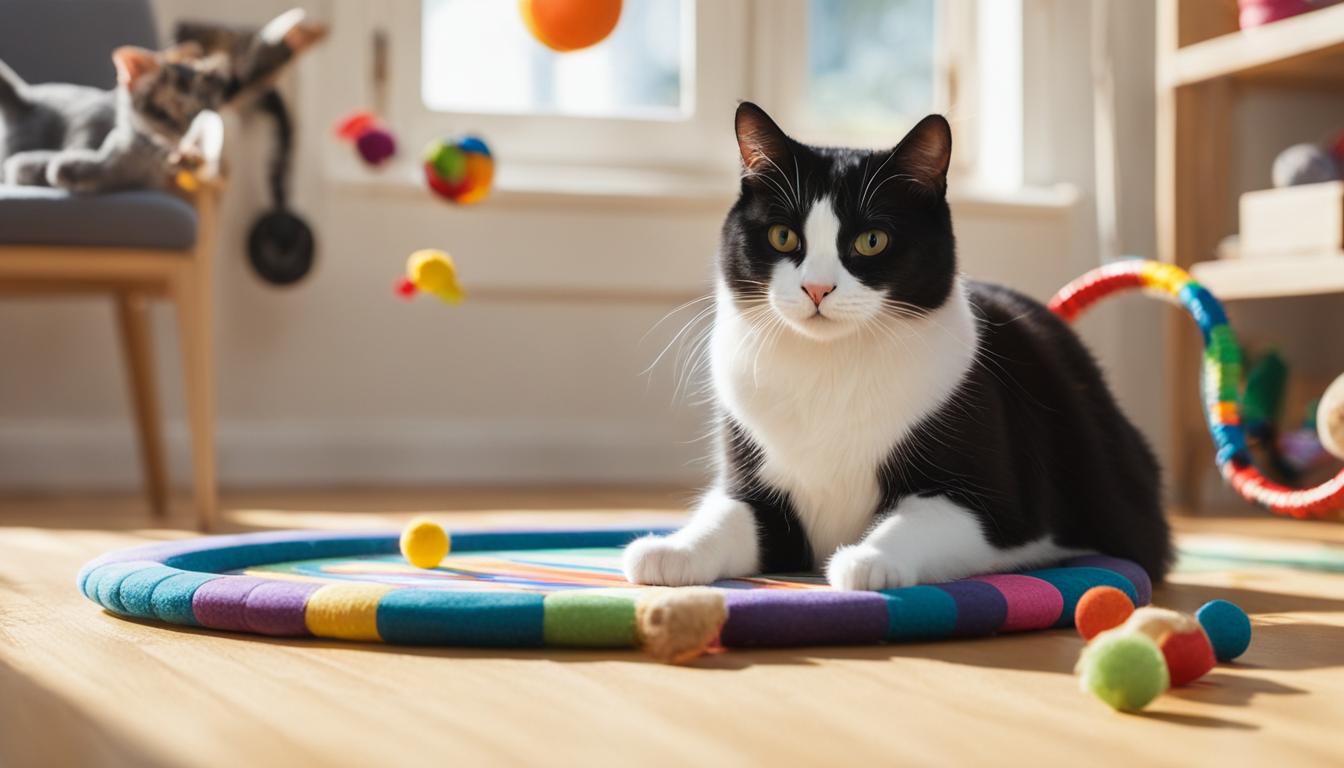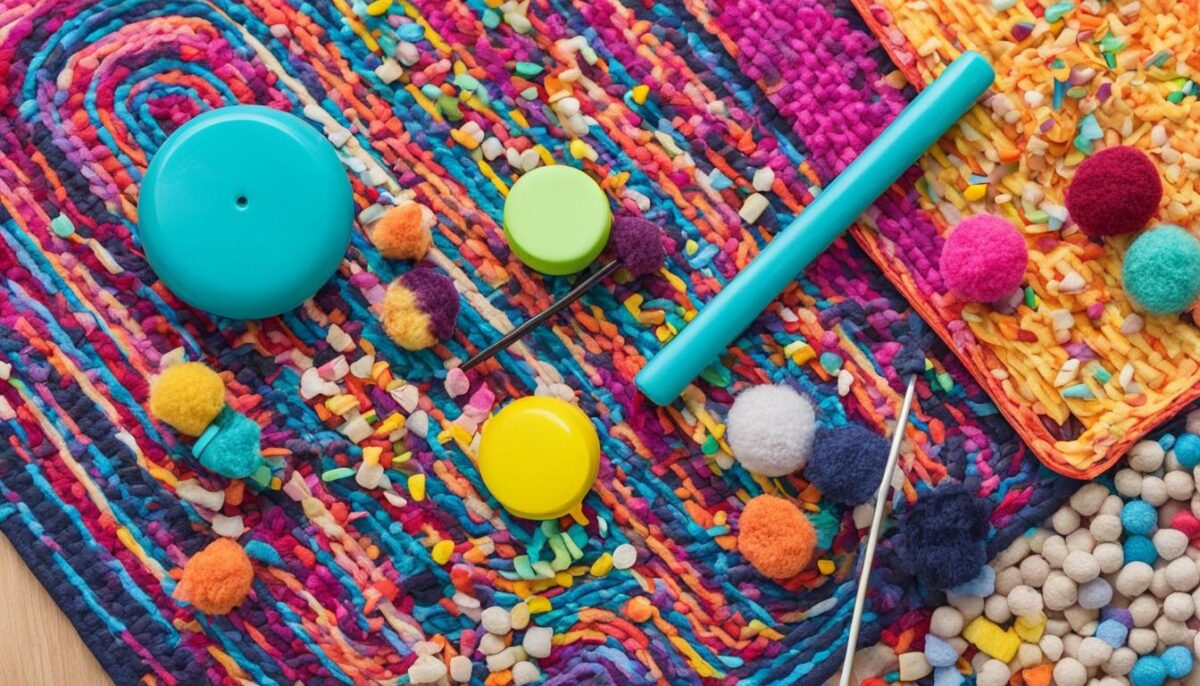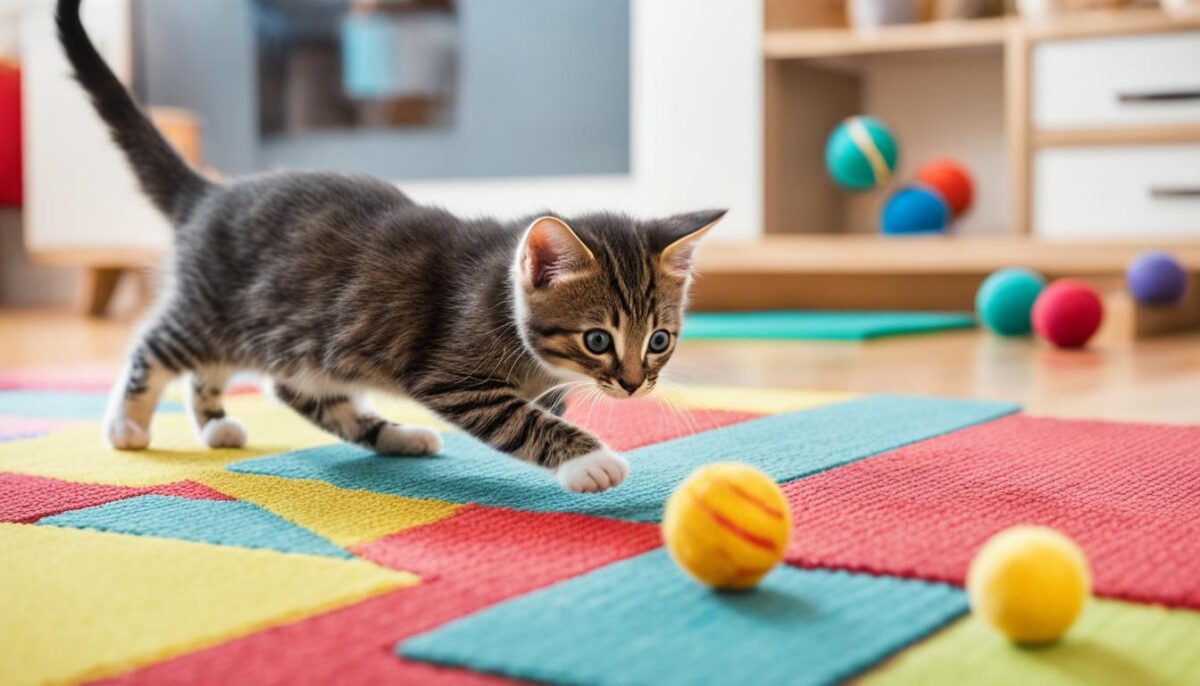Do you want to train your cat with some easy cat tricks? It can be a fun time for both you and your kitty. Training your cat at home helps them stay smart and happy. It’s like playing a cool new game, but with neat commands like “sit” or “high five”. To start, use tiny treats or their favorite plaything. This is called positive reinforcement. It makes learning fun!
Always be gentle and spend just a little time on training, like five minutes or less. This is because cats have short attention spans. You want to keep things fun, so they look forward to learning more. With some patience and treats, you’ll have a great time teaching your cat new tricks!
Here’s a fun trick to try. Use a clicker when your cat does something right, like sitting. It tells them, “Hey, good job!” Remember, short lessons, treats, and play make for the best learning time at home.
Key Takeaways
- Training your cat can be like a fun game.
- Use treats and toys for motivation.
- Keep training time short and happy.
- Try clicker training to help your cat learn.
- End with playtime to make your cat eager for next time.
Understanding Your Cat’s Learning Style
Hey there, cat lovers! Have you ever wondered why your furry friend does what it does? Let’s dive into the world of cat behavior and see how you can use cat training techniques to teach your kitty some fun and useful tricks using reward-based training.
Communication Through Behavior
Cats have their own way of telling us what they want. They might meow, purr, or even bring us a toy when they want to play. When you understand these signals, you can use them to teach your cat new things!
Reward-Based Motivation for Felines
Your kitty likes to know what’s in it for them. Giving them a tasty treat or some playtime when they do something right tells them they’re on the right track. This way, they’re more likely to do that cool trick again.
Including Positive Reinforcement in Training
Instead of being upset when your cat does something you don’t like, show them love when they do something great. This helps build a strong friendship between you and your cat. Friends don’t get mad at each other, right?
| Trick | Behavior | Reward |
|---|---|---|
| Sit | Cat sits down | Give a treat |
| High Five | Cat puts paw up | Extra playtime |
| Come Here | Cat comes when called | Favorite toy |
Preparations for Training Your Cat at Home
Are you thinking about setting up for cat training? Before you start, let’s make sure you’ve got all the cat training essentials. It’s like packing a bag for a fun trip. You’ll need some tasty treats, a neat little clicker, and fun toys to play with! Imagine you’re going on an adventure with your furry friend, and these are the tools you’ll use to find the treasure: a well-trained, happy cat!
It’s good to use a harness if you plan to teach your cat to walk with you. Harnesses are better than collars because they hug your cat’s body and keep them cozy and safe. Think of it as a fancy little vest your cat wears for outdoor adventures!
Now, every cat is unique, like a snowflake. They have their favorite games and snacks. By knowing what makes your cat’s eyes light up, you can make training super fun for them! It’s all about encouraging those natural behaviors and teaching your cat to show off those cool moves when you ask.
| Training Tool | Use for | Tips |
|---|---|---|
| Treats | Rewarding good actions | Choose healthy options your cat loves |
| Clicker | Marking the right moment | Click at the exact time your cat does well |
| Toys | Making training a game | Find toys that really get your cat moving |
| Harness | Safe outdoor walking | Get a snug fit and let your cat get used to wearing it |
By having all this cool gear ready, you’ll be all set to help your cat learn awesome tricks, and both of you will have a blast! Just remember, keep it silly and sweet, and your kitty will be doing high-fives in no time!
Simple Cat Tricks to Train: A Step-by-Step Approach
Hey there, cat lovers! Are you ready to turn your kitty into a trickster? Great, because teaching your furry friend some neat tricks is not only fun but also a fantastic way to bond. Let’s dive into some simple tricks that you can start with. Remember to grab some treats, and let’s get started!
Introducing the ‘Sit’ Command
Ever seen a cat sit on command like a pro? It’s easier than you think! When your cutie is about to sit, say “sit,” and then give them a treat right when they plop down. Soon, they’ll know that “sit” means “time for a yummy snack!”
Training Your Cat to ‘High Five’
Giving a high five is a cool trick for cool cats. Hold a treat in your hand and let them sniff it. They’ll lift a paw, and that’s when you say “high five.” Give them that treat to say, “You did awesome!”
Making Your Cat ‘Come’ on Command
Want your kitty to come when called? Shake that treat cup and say “come.” Give them a treat as soon as they trot over. Practice this, and soon they’ll be sprinting to you whenever you call!
The Role of Play in Cat Training
When you train your cat, adding play to the lesson makes everything more fun. Just like kids who learn while they play, cats do the same! Playtime helps your kitty learn new things, just like they would if they were out in the wild. Remember, the way your cats play is a big part of training them to do cool things. Let’s explore how play and toys are a big help when training your furry friend.
Encouraging Natural Behaviors Through Games
During play, cats show off their natural skills. It’s like when they chase and pounce; they’re really practicing hunting! By turning these fun actions into games, your cat can learn to listen to you and maybe try some neat tricks. It’s a way to make learning fun for them and for you. Plus, they get to stretch and bounce around, which is great for their health.
Using Toys to Enhance Training Efficiency
Have you thought about enhancing training with toys? Toys are not just for fun; they make learning faster and keep your cat’s brain busy. Imagine using a toy mouse when teaching your cat to ‘find it’ or ‘come’. The toy makes them think they’re really hunting and gets them super focused. Plus, a toy can be a prize they want to work for. So, it’s a win-win: they play, they learn, and they’re happy!
Ending Training Sessions on a Positive Note with Play
After learning tricks, ending with playtime makes your cat remember training as a happy time. It could be their favorite ball or a feather on a string—they won’t care as long as it’s fun! This way, they can’t wait for the next time you say it’s training time. It’s like the dessert after a meal; it’s the best part that they look forward to. And guess what? This playtime helps you and your cat become even better friends.
Common Mistakes to Avoid While Training Your Cat
When you train your cat, it’s all about having fun and learning together! But sometimes, small mistakes can make training harder. Here are things you should look out for!
Skipping Practice Time: Just like learning to play a game, your cat needs regular practice to learn new tricks. Try to train every day, even if it is just for a few minutes.
Not Using Treats: Remember, cats love treats! They can help your cat learn faster. Always keep your cat’s favorite snacks handy to make training a tasty time.
Being Impatient: Cats learn at their own speed. If your furry friend needs more time to learn a trick, that’s okay! Always be patient and give them the time they need.
Forgetting to Play: Cats also need to play. It helps them to learn and be happy. Make sure to mix training with lots of fun playtime.
Too Much at Once: Trying to teach too many tricks at one time can be confusing for your cat. Stick with one trick until your cat does it really well, then you can try a new one.
Training for Too Long: Cats can get bored if training takes too long. Keep sessions short and sweet so your cat stays excited about learning.
Only Training Inside: If you have a safe outside space, try some training there too! Cats enjoy new places and smells, and it might make training even more fun.
| What to Avoid | Reason | What to Do Instead |
|---|---|---|
| Yelling | Makes cats scared or nervous | Use a happy voice to encourage your cat |
| Forgetting Rewards | Cats won’t know they did something good | Use treats or playtime as a reward |
| Too Much Noise | Cats can’t focus with a lot of noise around | Find a quiet space to train without distractions |
| Not Being Consistent | Cats get confused if the rules keep changing | Always use the same words and actions for each trick |
To make the most of your training time together, watch out for these mistakes and you’ll both have a fun time learning and playing!
Advanced Training Techniques for Curious Cats
Have you ever watched your curious cat explore and thought, “Wow, they’re really smart”? Well, if you’re ready to take your feline friend’s training to the next level, there are some advanced techniques you can try! These methods will challenge your cat’s mind and help strengthen the bond between you two.
First things first, make sure you’ve mastered the basics. Your cat should already respond well to simple commands like ‘sit’ and ‘come’. If you’re both comfortable with those, it’s time to move on to something more challenging.
One advanced technique is obstacle course training. You can set up a small course in your living room with items like boxes and soft barriers. Encourage your cat to jump over, crawl under, and weave through the course. Always use a positive tone, and reward them with a treat or cuddle after each completed task.
Puzzle toys are another great way to get your cat’s brain working. These toys require cats to solve a problem to get a treat, which is perfect for curious kitties. Start with simpler puzzles and gradually introduce more complex ones to keep your cat interested and challenged.
Clicker training can also be taken to an advanced level. Try teaching your cat to turn lights on and off with their paw or to open drawers. Remember, patience is key, and always reinforce these behaviors with rewards.
- Obstacle Courses
- Puzzle Toys
- Advanced Clicker Training
- Trick Sequences
Combining tricks for a trick sequence is the pinnacle of cat training. Have your cat perform a series of actions like ‘sit’, ‘high five’, and ‘roll over’ in a sequence for a supreme display of intelligence and training.
Now, to add a visual element to this section, let’s look at an image that captures our theme:
Use these techniques consistently, and you’ll be surprised at what your cat can accomplish. Remember, training should always be fun for both of you. So keep things positive, and don’t forget to show lots of love and praise to your clever cat!
Conclusion
If you’ve made it this far, you now know lots about teaching your cat cool tricks. Remember, every cat learns differently, so it’s okay if yours takes a little extra time to get the hang of things. Keep your training times short and fun, using yummy treats and your cat’s favorite games to say “you did great!” It’s like a little party for your cat every time they learn something new.
Even though we didn’t fill out Sections 6, 7, and 8, think of this guide as a starting point for you and your furry buddy. As you practice, you’ll probably think of new tricks and better ways to teach. That’s awesome! Growing and learning together is a big part of training. And if you ever get stuck or need more ideas, there’s a bunch of neat stuff you can find to help keep training exciting for both of you.
So grab those treats, get your clicker, and start practicing ‘sit’, ‘high five’, and ‘come here’ with your cat. Just remember to keep it all about fun and love. You’re not just teaching tricks; you’re bonding with your cat, and that’s the best trick of all! Keep up the good work, and enjoy every purr and paw high five along the way.
FAQ
How can I start to train my cat at home?
Begin by setting up a quiet, distraction-free area with essential tools such as treats, toys, and a clicker. Use short, positive sessions to introduce simple commands, rewarding your cat’s natural behaviors with treats or play to encourage them.
What are the best techniques for understanding my cat’s behavior during training?
Pay close attention to your cat’s body language and vocalizations. Cats communicate largely through behavior, so recognizing these cues can help you tailor your training to their preferences and reactions.
Why is reward-based training important for cats?
Cats are motivated by rewards that they find valuable, such as treats or playful activities. Reward-based training, especially with food or fun incentives, helps keep your cat engaged and willing to participate in the learning process.
How can I teach my cat the ‘sit’ command?
Wait for your cat to naturally sit, then introduce the ‘sit’ cue, followed promptly by a treat or reward. Repeat this process to reinforce the command until your cat sits on cue reliably.
What’s the best way to get my cat to ‘high five’?
Hold a treat in your hand close to your cat’s paw level. When they reach up with their paw, say “high five,” and reward them as soon as they touch your hand. Repeat until they associate the command with the action.
How do I train my cat to come when called?
Begin by associating the sound of a treat cup or your voice with positive experiences. Call your cat’s name and reward them immediately when they arrive. Practice regularly, gradually increasing the distance between you.
Can playtime really help with training my cat?
Yes, playtime is crucial in cat training as it provides mental and physical stimulation, mimics their hunting behaviors, and fosters a stronger bond between you two. Ending sessions with play ensures a positive experience.
What common mistakes should I avoid when training my cat?
Avoid negative reinforcement or punishment, as these can damage your relationship with your cat. Also, keep training sessions short to prevent boredom, and don’t push your cat beyond their comfort zone or patience level.
Are there advanced techniques for training my curious cat?
Yes, once your cat has mastered basic commands, you can move on to more complex tricks like agility courses, puzzle toys, or learning to walk on a leash. Always use positive reinforcement and progress at your cat’s pace.


